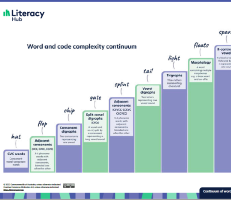Word and code complexity continuum
Categories
Audience
Purpose
Topic
Details
Source
Literacy Hub
Copyright
(c) Commonwealth of Australia
Note: depending on your settings, the continuum image on the final page may not display if you view the PDF through your browser. To view the full document download it and view with a PDF reader.
Overview
This diagram shows the gradual progression of skills that students need to develop so they can read and spell words with increasing complexity.
Who is this document for?
Foundation to Year 2 teachers; school leaders.
What will you learn?
By understanding this continuum, teachers can strategically support students to develop strong decoding (reading) and encoding (spelling) skills by teaching at students’ point of need.
Related content
This phonics instructional model for reading and spelling outlines the attributes of instruction, a lesson and review model, a sample phonics lesson and examples of skill application tasks.
This slide pack provides a sample daily review, a key component of teaching phonics following a systematic synthetic phonics (SSP) approach, using evidence-based research. It can be adapted to follow any phonics progression or lesson.
Phonics professional learning: Explicit instruction for phonics – an instructional model
The Literacy Hub provides free, online professional learning to support schools through each step of building a systematic synthetic phonics (SSP) approach for reading and spelling. This second topic in the series unpacks explicit instruction and an instructional model for phonics.
Introduction to SSP video series
Jocelyn Seamer, an expert in systematic reading instruction, presents a series of videos about systematic synthetic phonics (SSP). View the first video in the series.
Back to search results